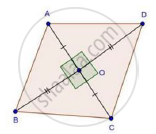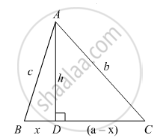Advertisements
Advertisements
प्रश्न
The lengths of the diagonals of a rhombus are 24 cm and 10 cm. Find each side of the rhombus.
उत्तर

We have,
ABCD is a rhombus with diagonals AC = 10 cm and BD = 24 cm
We know that diagonal of a rhombus bisect each other at 90°
∴ AO = OC = 5 cm and BO = OD = 12 cm
In ΔAOB, by Pythagoras theorem
AB2 = AO2 + BO2
⇒ AB2 = 52 + 122
⇒ AB2 = 25 + 144 = 169
⇒ AB = `sqrt169` = 13 cm
APPEARS IN
संबंधित प्रश्न
Two poles of height 9 m and 14 m stand on a plane ground. If the distance between their feet is 12 m, find the distance between their tops.
Each side of a rhombus is 10 cm. If one of its diagonals is 16 cm find the length of the other diagonal.
In the given figure, ∠B < 90° and segment AD ⊥ BC, show that
(i) b2 = h2 + a2 + x2 - 2ax
(ii) b2 = a2 + c2 - 2ax

In ∆ABC, ∠A is obtuse, PB ⊥ AC and QC ⊥ AB. Prove that:
(i) AB ✕ AQ = AC ✕ AP
(ii) BC2 = (AC ✕ CP + AB ✕ BQ)
State Pythagoras theorem
If D, E, F are the respectively the midpoints of sides BC, CA and AB of ΔABC. Find the ratio of the areas of ΔDEF and ΔABC.
From given figure, In ∆ABC, AB ⊥ BC, AB = BC, AC = `2sqrt(2)` then l (AB) = ?
Find the height of an equilateral triangle having side 4 cm?
A girl walks 200m towards East and then 150m towards North. The distance of the girl from the starting point is ______.
In a ΔABC, ∠CAB is an obtuse angle. P is the circumcentre of ∆ABC. Prove that ∠CAB – ∠PBC = 90°.
